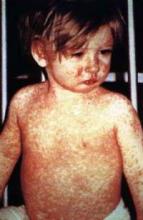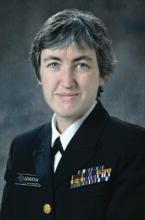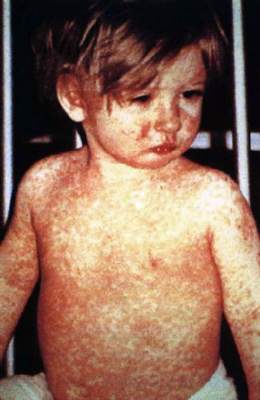User login
Physicians should have a high degree of suspicion for measles when a patient presents with fever, rash, and other measles-related symptoms, CDC officials advised Jan. 29.
“I’m urging all health care professionals to think ‘measles’ when they’re evaluating patients with fever, rash, and other measles-related symptoms,” Dr. Anne Schuchat, the U.S. assistant surgeon general, and the director of the Centers for Disease Control and Prevention’s National Center for Immunization and Respiratory Diseases, said during a press conference. “Health care professionals need to know the guidelines for infection control and reporting measles cases, and they should work to ensure that patients are getting the best protection possible against measles, which is on-time MMR [measles, mumps, and rubella] vaccination, to protect them whether at home or abroad.”
Early symptoms include cough, runny nose and red, light-sensitive eyes. Two to four days later, a fine rash of red spots develops on the face and then gradually spreads down over the entire body. Fever, which can reach 103-105° F, comes with the rash. White spots, called Koplik spots, may appear on the inside of the cheeks.
Measles is more contagious than almost any other disease. The virus that causes measles lives in the nose and throat of infected people and is sprayed into the air when an infected person sneezes, coughs or talks, and can stay in the air for up to 2 hours. People with measles can spread the disease starting 4 days before the rash begins until 4 days after it appears.
At least 84 people across 14 states have been diagnosed recently with measles, including at least 67 who are thought to have been infected in mid- to late December while visiting Disneyland in Anaheim, Calif., Dr. Schuchat said. “We believe someone got infected [with measles] overseas, visited the Disneyland park, and spread the disease to others.” Those people went on to expose others in a variety of settings, including schools, day care centers, outpatient clinics, and airplanes, she added.
“This is not a problem of the measles vaccine not working, this is a problem of the measles vaccine not being used,” Dr. Schuchat said.
The CDC’s Advisory Committee on Immunization Practices recommends that children between 6 months and 12 months of age be vaccinated, particularly if they will be traveling, since many countries still experience measles on a much larger scale than in the United States.
For parents who balk at this, Dr Schuchat said, “The reason that MMR is recommended at 12 months routinely is because babies are exquisitely vulnerable to measles and the complications from measles.”
The CDC does not recommend the vaccine for children younger than 6 months and urged physicians to remind parents to have their children vaccinated with the recommended two additional doses after their children reach 12 months. “Between 6 and 12 months, it will protect, but it won’t last that long.”
The CDC is also urging adults to be sure of their vaccination status. Adults who are unsure whether they are immune to the virus, either through vaccination or from having had the disease, should get vaccinated or at the least discuss it with their physician. “There is no harm in getting another MMR vaccine if you’ve already been vaccinated,” Dr. Schuchat said.
The majority of measles cases over the past few years, she said, have been in persons who were unvaccinated, primarily because of personal beliefs. Others, however, were unvaccinated because of a missed opportunity.
“People were at the doctor’s office and didn’t get their vaccine because they had an illness, but we recommend you get vaccinated when you are there,” she said.
Already in January 2015, the United States has seen more than the median number of measles cases typically recorded annually since the virus was eliminated as a native disease. In 2014, a record number of 644 cases from 27 states reported to CDC’s National Center for Immunization and Respiratory Diseases.
“This is a wake-up call to make sure that we keep measles from gaining a foothold in our country,” Dr. Schuchat said.
The recommended vaccination schedules for children and adults can be found on the CDC website.
On Twitter @whitneymcknight
*Updated on 1/30/15
Physicians should have a high degree of suspicion for measles when a patient presents with fever, rash, and other measles-related symptoms, CDC officials advised Jan. 29.
“I’m urging all health care professionals to think ‘measles’ when they’re evaluating patients with fever, rash, and other measles-related symptoms,” Dr. Anne Schuchat, the U.S. assistant surgeon general, and the director of the Centers for Disease Control and Prevention’s National Center for Immunization and Respiratory Diseases, said during a press conference. “Health care professionals need to know the guidelines for infection control and reporting measles cases, and they should work to ensure that patients are getting the best protection possible against measles, which is on-time MMR [measles, mumps, and rubella] vaccination, to protect them whether at home or abroad.”
Early symptoms include cough, runny nose and red, light-sensitive eyes. Two to four days later, a fine rash of red spots develops on the face and then gradually spreads down over the entire body. Fever, which can reach 103-105° F, comes with the rash. White spots, called Koplik spots, may appear on the inside of the cheeks.
Measles is more contagious than almost any other disease. The virus that causes measles lives in the nose and throat of infected people and is sprayed into the air when an infected person sneezes, coughs or talks, and can stay in the air for up to 2 hours. People with measles can spread the disease starting 4 days before the rash begins until 4 days after it appears.
At least 84 people across 14 states have been diagnosed recently with measles, including at least 67 who are thought to have been infected in mid- to late December while visiting Disneyland in Anaheim, Calif., Dr. Schuchat said. “We believe someone got infected [with measles] overseas, visited the Disneyland park, and spread the disease to others.” Those people went on to expose others in a variety of settings, including schools, day care centers, outpatient clinics, and airplanes, she added.
“This is not a problem of the measles vaccine not working, this is a problem of the measles vaccine not being used,” Dr. Schuchat said.
The CDC’s Advisory Committee on Immunization Practices recommends that children between 6 months and 12 months of age be vaccinated, particularly if they will be traveling, since many countries still experience measles on a much larger scale than in the United States.
For parents who balk at this, Dr Schuchat said, “The reason that MMR is recommended at 12 months routinely is because babies are exquisitely vulnerable to measles and the complications from measles.”
The CDC does not recommend the vaccine for children younger than 6 months and urged physicians to remind parents to have their children vaccinated with the recommended two additional doses after their children reach 12 months. “Between 6 and 12 months, it will protect, but it won’t last that long.”
The CDC is also urging adults to be sure of their vaccination status. Adults who are unsure whether they are immune to the virus, either through vaccination or from having had the disease, should get vaccinated or at the least discuss it with their physician. “There is no harm in getting another MMR vaccine if you’ve already been vaccinated,” Dr. Schuchat said.
The majority of measles cases over the past few years, she said, have been in persons who were unvaccinated, primarily because of personal beliefs. Others, however, were unvaccinated because of a missed opportunity.
“People were at the doctor’s office and didn’t get their vaccine because they had an illness, but we recommend you get vaccinated when you are there,” she said.
Already in January 2015, the United States has seen more than the median number of measles cases typically recorded annually since the virus was eliminated as a native disease. In 2014, a record number of 644 cases from 27 states reported to CDC’s National Center for Immunization and Respiratory Diseases.
“This is a wake-up call to make sure that we keep measles from gaining a foothold in our country,” Dr. Schuchat said.
The recommended vaccination schedules for children and adults can be found on the CDC website.
On Twitter @whitneymcknight
*Updated on 1/30/15
Physicians should have a high degree of suspicion for measles when a patient presents with fever, rash, and other measles-related symptoms, CDC officials advised Jan. 29.
“I’m urging all health care professionals to think ‘measles’ when they’re evaluating patients with fever, rash, and other measles-related symptoms,” Dr. Anne Schuchat, the U.S. assistant surgeon general, and the director of the Centers for Disease Control and Prevention’s National Center for Immunization and Respiratory Diseases, said during a press conference. “Health care professionals need to know the guidelines for infection control and reporting measles cases, and they should work to ensure that patients are getting the best protection possible against measles, which is on-time MMR [measles, mumps, and rubella] vaccination, to protect them whether at home or abroad.”
Early symptoms include cough, runny nose and red, light-sensitive eyes. Two to four days later, a fine rash of red spots develops on the face and then gradually spreads down over the entire body. Fever, which can reach 103-105° F, comes with the rash. White spots, called Koplik spots, may appear on the inside of the cheeks.
Measles is more contagious than almost any other disease. The virus that causes measles lives in the nose and throat of infected people and is sprayed into the air when an infected person sneezes, coughs or talks, and can stay in the air for up to 2 hours. People with measles can spread the disease starting 4 days before the rash begins until 4 days after it appears.
At least 84 people across 14 states have been diagnosed recently with measles, including at least 67 who are thought to have been infected in mid- to late December while visiting Disneyland in Anaheim, Calif., Dr. Schuchat said. “We believe someone got infected [with measles] overseas, visited the Disneyland park, and spread the disease to others.” Those people went on to expose others in a variety of settings, including schools, day care centers, outpatient clinics, and airplanes, she added.
“This is not a problem of the measles vaccine not working, this is a problem of the measles vaccine not being used,” Dr. Schuchat said.
The CDC’s Advisory Committee on Immunization Practices recommends that children between 6 months and 12 months of age be vaccinated, particularly if they will be traveling, since many countries still experience measles on a much larger scale than in the United States.
For parents who balk at this, Dr Schuchat said, “The reason that MMR is recommended at 12 months routinely is because babies are exquisitely vulnerable to measles and the complications from measles.”
The CDC does not recommend the vaccine for children younger than 6 months and urged physicians to remind parents to have their children vaccinated with the recommended two additional doses after their children reach 12 months. “Between 6 and 12 months, it will protect, but it won’t last that long.”
The CDC is also urging adults to be sure of their vaccination status. Adults who are unsure whether they are immune to the virus, either through vaccination or from having had the disease, should get vaccinated or at the least discuss it with their physician. “There is no harm in getting another MMR vaccine if you’ve already been vaccinated,” Dr. Schuchat said.
The majority of measles cases over the past few years, she said, have been in persons who were unvaccinated, primarily because of personal beliefs. Others, however, were unvaccinated because of a missed opportunity.
“People were at the doctor’s office and didn’t get their vaccine because they had an illness, but we recommend you get vaccinated when you are there,” she said.
Already in January 2015, the United States has seen more than the median number of measles cases typically recorded annually since the virus was eliminated as a native disease. In 2014, a record number of 644 cases from 27 states reported to CDC’s National Center for Immunization and Respiratory Diseases.
“This is a wake-up call to make sure that we keep measles from gaining a foothold in our country,” Dr. Schuchat said.
The recommended vaccination schedules for children and adults can be found on the CDC website.
On Twitter @whitneymcknight
*Updated on 1/30/15
FROM A CDC PRESS CONFERENCE


